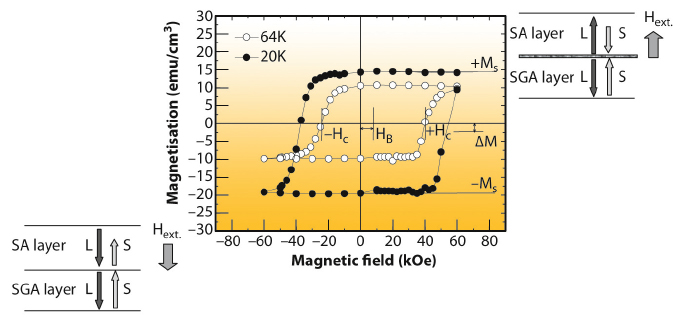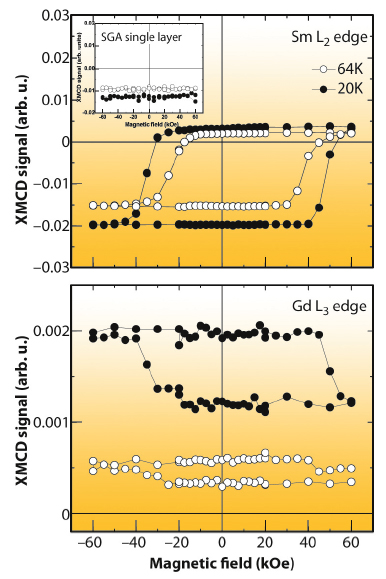- Home
- Users & Science
- Scientific Documentation
- ESRF Highlights
- ESRF Highlights 2011
- Electronic structure and magnetism
- Observation of a zero-magnetisation ferromagnet in exchange-coupled system
Observation of a zero-magnetisation ferromagnet in exchange-coupled system
Magnetic materials possessing long range ferromagnetic order with zero magnetisation are of considerable interest for applications in spintronics devices. To date, there has been only one experimental realisation of such a ferromagnet, obtained by substituting a small amount of Sm atoms by Gd atoms in the SmAl2 intermetallic compound. The pure spin contribution from Gd atoms leads to complete cancellation of the small magnetisation resulting from antiparallel spin and orbital contributions of Sm atoms at a certain temperature Tcomp (compensation point), while individual magnetic moments maintain a long-range ferromagnetic order [1]. Exchange-coupled systems with such an unusual ferromagnet as pinned layer may be interestingly compared to conventional ferromagnetic/antiferromagnetic exchange bias systems, with the advantage that the remaining spin ferromagnetic order enables specific studies by electronic selective techniques such as X-ray magnetic circular dichroism (XMCD). This permits important issues relating to the exchange bias phenomena to be addressed, especially the influence of the ferromagnetic reversal on the biasing layer.
We have successfully developed the growth of Sm1-xGdxAl2 single crystalline thin films by molecular beam epitaxy [2] and confirmed the existence of a zero-magnetisation ferromagnetic state using XMCD [3-4].
The bilayers studied in this work combine a ferromagnetic material (SmAl2), dominated by the Sm orbital contribution, and the unusual ferromagnet (Sm1-xGdxAl2). The compensation point of the latter is about 64 K and its large coercivity inhibits the magnetisation reversal over the -7/+7 T field range below 80 K. Exchange bias phenomenon has been investigated by complementary macroscopic magnetisation and XMCD measurements.
Figure 77 presents the hysteresis loops (SQUID) measured for SmAl2/Sm1-xGdxAl2 at 20 K and at 64 K (Tcomp). The loops are obviously shifted along the field axis, as a result of the interface exchange coupling between SmAl2 and Sm1-xGdxAl2. The large bias field yields an interface energy of the order of 10 erg/cm2. The positive sign of the bias field arises from opposite orientations between spin moments of both compounds at +7 T. At 20 K, the shift of the loop along the magnetisation axis implies a pinned magnetic contribution.
 |
|
Fig. 77: Magnetisation measurements of Sm1-xGdxAl2/SmAl2 at 20 K and 64 K. The sketches present the magnetic configurations expected for large positive and negative magnetic fields. |
XMCD experiments (beamline ID12) have been carried out to unravel the behaviour of the zero magnetisation ferromagnet during the SmAl2 magnetisation reversal. XMCD signals at the Gd L2,3 absorption edges permit to selectively probe Sm1-xGdxAl2, even in its compensated state.
Results obtained for the uncovered Sm1-xGdxAl2 film confirmed the pinned magnetisation over the -7/+7 T field range (inset Figure 78). In the bilayer, the hysteresis loops recorded at the Sm L2 edge (Figure 78, top) exhibit strong horizontal and vertical shifts, in agreement with magnetometry results. The specific investigation of the biasing layer (Figure 78 bottom) reveals that a certain proportion of it rotates with field. The close coercive fields recorded at both edges confirm that Sm1-xGdxAl2 partial reversal is driven by exchange coupling to ferromagnetic layer. This reversal also occurs at compensation, although the external field has no effect on the zero magnetisation state.
The proportion of rotatable moments in Sm1-xGdxAl2 is approximately 20% at both temperatures, corresponding to an effective thickness of 60 nm. Given the large amount of rotatable moments compared to the wall thickness expected in this material, the scenario of an interface domain wall has been ruled out and the presence of lateral domains in Sm1-xGdxAl2 is strongly suggested.
In summary, SmAl2/Sm1-xGdxAl2 bilayers are an original exchange bias system. At the compensation point, a large bias field is observed that can be tuned by the magnetic configurations in Sm1-xGdxAl2. XMCD experiments offer the possibility to investigate the influence of the reversal of ferromagnetic layer on the compensated biasing layer. They reveal that a significant proportion of the zero magnetisation layer is driven to reverse by exchange-coupling to the ferromagnetic layer.
Principal publication and authors
M. Ungureanu (a), K. Dumesnil (a), C. Dufour (a), N. Gonzalez (a), F. Wilhelm (b), A. Smekhova (b) and A. Rogalev (b), Phys. Rev. B 82, 174421 (2010).
(a) Institut Jean Lamour (UMR 7198), Nancy Université, Vandoeuvre les Nancy (France)
(b) ESRF
References
[1] H. Adachi and H. Ino, Nature 401, 148-150 (1999).
[2] A. Avisou, C. Dufour, K. Dumesnil and D. Pierre, J. of Crystal Growth 297, 239 (2006).
[3] A. Avisou, K. Dumesnil and C. Dufour, J. Mag. Mag. Mat. 316, 317 (2007).
[4] A. Avisou, C. Dufour, K. Dumesnil, A. Rogalev, F. Wilhelm and E. Snoeck, J. of Phys.: Cond. Matter. 20, 265001 (2008).




